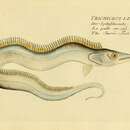Diagnostic Description
provided by Fishbase
Body extremely elongate, compressed and tapering to a point. Mouth large with a dermal process at the tip of each jaw. Dorsal fin relatively high; anal fin reduced to minute spinules usually embedded in the skin or slightly breaking through; anterior margin of pectoral fin spine not serrated. Pelvic and caudal fins absent. Lateral line beginning at the upper margin of the gill cover, running oblique to behind the tip of the pectoral fins, then straight close to the ventral contour. Fresh specimens steely blue with silvery reflections, becoming uniformly silvery gray sometime after death (Ref. 6181).
Diseases and Parasites
provided by Fishbase
Capillaria Infestation. Parasitic infestations (protozoa, worms, etc.)
Diseases and Parasites
provided by Fishbase
Camallanus Infection 2. Parasitic infestations (protozoa, worms, etc.)
Diseases and Parasites
provided by Fishbase
Hysterothylacium Infection (Hysterothylacium sp.). Parasitic infestations (protozoa, worms, etc.)
Diseases and Parasites
provided by Fishbase
Plerurus Infestation. Parasitic infestations (protozoa, worms, etc.)
Diseases and Parasites
provided by Fishbase
Camallanus Infection 13. Parasitic infestations (protozoa, worms, etc.)
Migration
provided by Fishbase
Amphidromous. Refers to fishes that regularly migrate between freshwater and the sea (in both directions), but not for the purpose of breeding, as in anadromous and catadromous species. Sub-division of diadromous. Migrations should be cyclical and predictable and cover more than 100 km.Characteristic elements in amphidromy are: reproduction in fresh water, passage to sea by newly hatched larvae, a period of feeding and growing at sea usually a few months long, return to fresh water of well-grown juveniles, a further period of feeding and growing in fresh water, followed by reproduction there (Ref. 82692).
Morphology
provided by Fishbase
Dorsal spines (total): 3; Dorsal soft rays (total): 130 - 135; Analsoft rays: 100 - 105
Trophic Strategy
provided by Fishbase
Generally over muddy bottoms of shallow coastal waters (Ref. 9351). Often enter estuaries (Ref. 9351). Adults and juveniles have opposing complementary vertical diurnal feeding migration. Juveniles and small adults form schools about 100 m above the bottom during daytime and form loose feeding aggregations at night-time near the surface where they prey on planktonic organisms such as euphausiids, small pelagic planktonic crustaceans and small fishes (anchovies, bregmacerotids, etc.). Large adults feed on pelagic prey (anchovies, sardines, myctophiids, bregmacerotids, carangoids, sphyraenids, atherinids, sciaenids, Scomber, Trichiurus, squid and crustaceans, etc.) near the surface during daytime and migrate to the bottom at night. One of the main predators during summer in a sandy beach at Canto Grande, Santa Catarina, Brazil (Ref. 55758).
Biology
provided by Fishbase
Generally over muddy bottoms of shallow coastal waters (Ref. 9351). Often enter estuaries (Ref. 9351). Juveniles feed mostly on euphausiids, small pelagic planktonic crustaceans and small fishes; adults feed mainly on fishes and occasionally on squids and crustaceans (Ref. 6181). Adults and juveniles have opposing complementary vertical diurnal feeding migration. Large adults usually feed near the surface during the daytime and migrate to the bottom at night. Juveniles and small adults form schools 100 m above the bottom during the daytime and form loose feeding aggregations at night near the surface. Pelagic eggs (Ref. 35388) and larvae (Ref. 6768). Max weight of 1.5 kg given in Ref. 28023 seems too low. The current angling world record was caught in Rio de Janeiro's Guanabara Bay and weighed 3.69 kg. Commercial fisherman have caught fish of up to 5 kg (Capt. Eduardo Baumeier, pers. Comm., 2001). Marketed salted or dried and also frozen (Ref. 9351). Excellent taste when fried or grilled; also for sashimi when fresh.
Importance
provided by Fishbase
fisheries: highly commercial; gamefish: yes; price category: high; price reliability: reliable: based on ex-vessel price for this species

